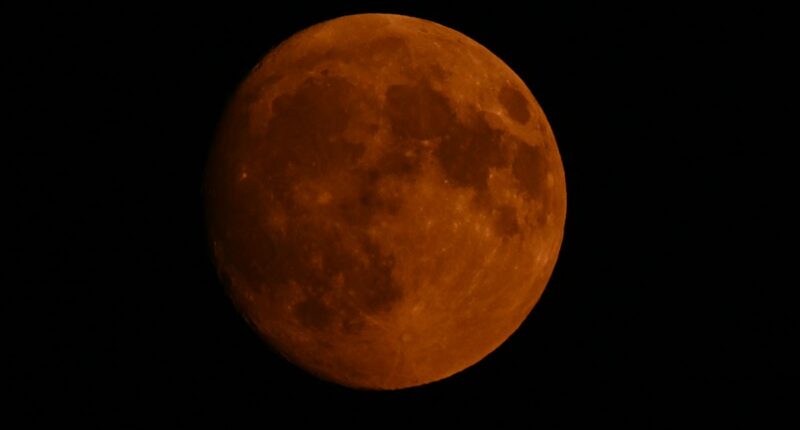Share this @internewscast.com
Stargazers are set to witness a breathtaking event this weekend as a total lunar eclipse will render the moon a blood red color for over an hour in some regions across the globe.
This astronomical phenomenon will take place on the night of September 7–8, 2025, as Earth positions itself directly in line between the Moon and the Sun, its large shadow being cast over the lunar surface.
As reported by Space.com, this will cause the moon to glow a deep red, a stunning effect produced when sunlight passes through Earth’s atmosphere, scattering the red and orange tones of sunrises and sunsets onto the moon’s surface.
Where the blood moon will be visible
This total eclipse will be entirely visible in vast areas of Asia, Africa, eastern Europe, and western Australia. Meanwhile, places like Spain and Norway will experience only a partial view of the eclipse.
In North and South America, a bright full ‘Corn Moon’ will light up the skies, according to CNN.
The Corn Moon earns its nickname because it coincides with the corn harvest, according to the Old Farmer’s Almanac.
Coinciding with the lunar eclipse, the Corn Moon will reach its peak, but it will appear full to the naked eye for a few nights. This allows observers the opportunity to enjoy its presence throughout the weekend and into Monday.
For those outside the blood moon viewing zone, several astronomy channels will provide free livestreams the night of the event, Space.com reported.

The Blood Moon will glow red for 82 minutes during this weekend’s rare total lunar eclipse
How the eclipse will unfold
Unlike a solar eclipse, which passes in minutes, a lunar eclipse is slow and dramatic, unfolding over several hours.
The event kicks off as the Moon begins to move into Earth’s subtle outer shadow, known as the penumbra, at 11:28 a.m. ET. Initially, this phase is delicately noticeable as a faint darkening across the moon’s surface.
At 12:27 p.m., the real drama begins as the Moon slips into Earth’s umbra, the darker central shadow.
The moment of totality arrives at 1:30 p.m., when the Moon is completely engulfed by the umbra.
The eclipse reaches its maximum at 2:11 p.m. By 2:52 p.m., the Moon slips back out of the shadow, and the event draws to a close at 4:55 p.m. after more than five hours in total.
According to Space.com, totality alone will last for an impressive 82 minutes – making this one of the longer eclipses in recent years.

Earth’s shadow moves across the Moon during the partial phase of the September 7–8 eclipse
Why the Moon turns red
The Moon turns red as it slips deeper into Earth’s shadow because sunlight passing through the atmosphere is bent toward it.
Shorter blue wavelengths scatter away, while the longer red and orange rays are refracted onto the lunar surface.
At times, the Moon can also show faint blue or purple fringes around the edges.
Sara Russell, a research scientist at London’s Natural History Museum, told CNN this effect is caused by sunlight filtering through Earth’s ozone layer.
What is a Corn Moon?
September’s full moon is traditionally known as the Corn Moon, a name rooted in farming folklore because it coincides with the annual corn harvest.
According to the Old Farmer’s Almanac, the Corn Moon often appears larger and brighter in the late summer sky, providing extra light for farmers bringing in their crops.
Those in the Americas who can’t see the eclipse will still be able to enjoy the Corn Moon glowing overhead all weekend.

At 1:30 p.m. ET, the Moon will be completely engulfed in Earth’s umbra and turn a fiery red
What’s next in the sky?
Just two weeks later, on September 21, a partial solar eclipse will be visible from southern Australia, parts of the Pacific, and Antarctica, according to Space.com.
And to close out 2025, stargazers can look forward to three consecutive supermoons – October’s Harvest Moon, November’s Beaver Moon and December’s Cold Moon – which the Farmers’ Almanac notes will all appear larger and brighter than usual.
The next total lunar eclipse will take place on March 3, 2026, and will favor the Americas, CNN reported.








